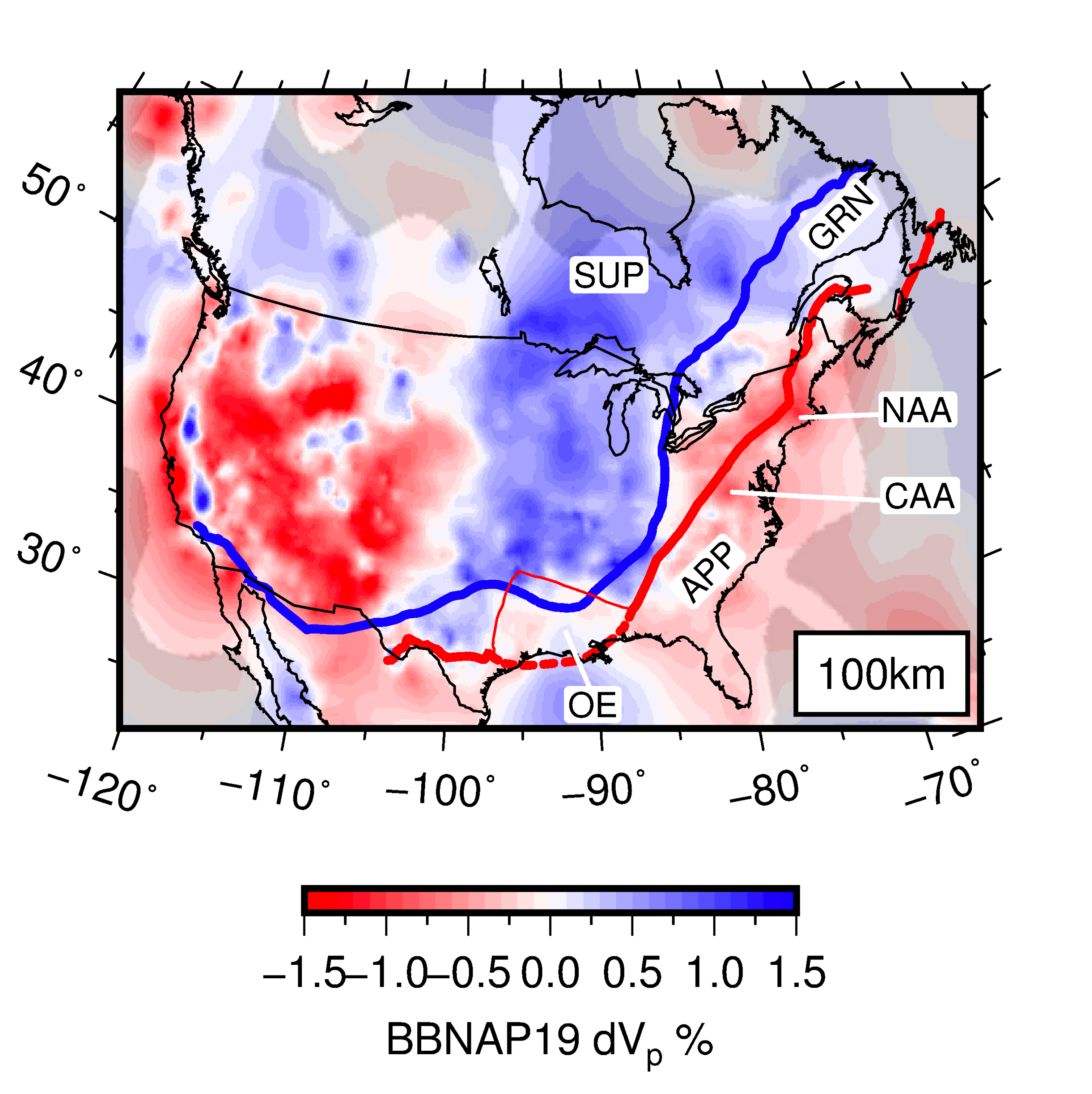Summary
BBNAP19, Boyce et al., (2019), is an absolute P-wave tomographic model with focus on eastern North American upper mantle structure.
Quicklinks
Description
| Name | BBNAP19 |
| Title | An absolute P-wave tomographic model with focus on eastern North American upper mantle structure. |
| Type | 3-D absolute P-wave tomographic model Earth Model |
| Sub Type | P-wave Velocity and P-wave Velocity Anomaly |
| Year | 2019 |
| Short Description | BBNAP19 is an adaptively parameterized, global absolute P-wave tomographic model following the methodologies of Li et al., (2008) and Burdick et al., (2017). ak135 (Kennett et al., 1995) is used as the global reference model. New data has been added in eastern U.S. and Canada, so we provide only the North American component of the model here. While the adaptively parameterized grids at upper mantle depths are shown in the supplementary material of published manuscript, here we provide the model sampled at 0.25×0.25 degrees and 50km depth to facilitate smooth plotting. The 3D grid contains the columns: depth (km), latitude (deg), longitude (deg), dVp (percentage relative to ak135), vp (absolute vp in km/s). Also available is a resolution mask for the upper part of the model. BBNAP19-MASK is based on the adaptively parameterized, global absolute P-wave tomographic model following the methodologies of Li et al., (2008) and Burdick et al., (2017). The file contains the masked regions used to plot grey shaded areas in Figure 5 of the main manuscript (Boyce et al., 2019). Regions with less than adequate resolution in BBNAP19 are determined following the methodology of Burdick et al., (2014). Regions where the mask is on (i.e. equal to 1) are regions of low confidence or poor resolution. Regions where the mask is off (i.e. equal to 0) are regions of high confidence or good resolution. Values between these two extremes result from sampling the adaptively parameterized grid at 0.25×0.25 degree intervals to facilitate smooth plotting. The 3D grid contains the columns: depth (km), latitude (deg), longitude (deg), mask on (1/0). |
| Authors: | |
| Alistair Boyce | |
| University of Cambridge, Department of Earth Science, Bullard Laboratories, Madingley Road, Cambridge, CB3 0EZ, UK | |
| Ian D. Bastow | |
| Department of Earth Science and Engineering, Royal School of Mines, Prince Consort Road, Imperial College London, London, SW7 2BP, UK | |
| Eva. M. Golos | |
| Department of Earth, Atmospheric and Planetary Sciences, Massachusetts Institute of Technology, Cambridge, Massachusetts, USA | |
| Stéphane Rondenay | |
| Department of Earth Science, University of Bergen, Allegaten 41, 5007 Bergen, Norway | |
| Scott Burdick | |
| Department of Geology, Wayne State University, Detroit, Michigan, 48202, USA | |
| Robert D. Van der Hilst | |
| Department of Earth, Atmospheric and Planetary Sciences, Massachusetts Institute of Technology, Cambridge, Massachusetts, USA | |
| Previous Model | None |
| Reference Model | ak135 |
| Model Download |
|
| Model Homepage | https://www.esc.cam.ac.uk/directory/alistair-boyce |
| Depth Coverage | 50 to 1000 km |
| Area | Latitude 8.0° to 82.0°, Longitude -144.0° to -38.0° |
| Data Set Description | Our global dataset of absolute arrival-time picks includes P, PP, Pn, Pg, pP, PKP, PKiKP and PKIKP phases from the “EHB” database (Engdahl et al., 1998) spanning the period 1964−2007 (Li et al., 2008a). We supplement the global dataset with the USArray Transportable Array (TA) (e.g., Burdick et al., 2017) which provides absolute arrival-time residuals for P, Pn, PP, PKP, PKiKP and PKIKP phases for 24288 earthquakes recorded between April 2004 and May 2016. We extend resolution northwards into the Canadian Shield regions by incorporating numerous smaller regional seismic networks. These include 9032 P arrivals from 238 earthquakes recorded in southeast Canada at 160 stations over the period 2007−2016, 3766 P arrivals from temporary seismic networks in the western Superior Province and 3599 P arrivals from the QM-III seismic network, that traverses the interior of Québec to the Canadian Maritimes. Further details on analysis of these datasets can be found in the main manuscript (Boyce et al., 2019). |
| Supplemental Information |

North America, plotted with respect to ak135. Grey regions are poorly resolved.
Please see the referenced manuscript for further information regarding the
tectonic features shown.
Citations and DOIs
To cite the original work behind this Earth model:
- Boyce, A., I. D. Bastow, E. M. Golos, S. Rondenay, S. Burdick and R. Van der Hilst (2019), Variable modification of continental lithosphere during the Proterozoic Grenville orogeny: Evidence from teleseismic P-wave tomography, Earth and Planetary Science Letters, 525, 115763, https://doi.org/10.1016/j.epsl.2019.115763.
To cite IRIS DMC Data Products effort:
- Trabant, C., A. R. Hutko, M. Bahavar, R. Karstens, T. Ahern, and R. Aster (2012), Data Products at the IRIS DMC: Stepping Stones for Research and Other Applications, Seismological Research Letters, 83(5), 846–854, https://doi.org/10.1785/0220120032.
DOI for this EMC webpage:
References
- Burdick et al., (2014) Model Update January 2013: Upper Mantle Heterogeneity beneath North America from Travel-Time Tomography with Global and USArray Transportable Array Data. Seis. Res. Lett. 85, 77–81. https://doi.org/10.1785/0220130098.
- Burdick et al., (2017) Model update May 2016: upper-mantle heterogeneity beneath North America from travel-time tomography with global and USArray data. Seismol. Res. Lett., 88, pp. 319-325, https://doi.org/10.1785/0220160186.
- Engdahl, et al., (1998). Global teleseismic earthquake relocation with improved travel times and procedures for depth determination. Bull. Seismol. Soc. Am. 88, 722–743.
- Kennett, et al., (1995). Constraints on seismic velocities in the earth from traveltimes. Geophys. J. Int. 122, 108–124. https://doi.org/10.1111/j.1365-246X.1995.tb03540.x.
- Li et al., (2008) A new global model for P wave speed variations in Earth’s mantle. Geochem. Geophys. Geosyst., 9, https://doi.org/10.1029/2007GC001806.
Credits
Model provided by Alistair Boyce
Timeline
- 2019-09-27
- online






